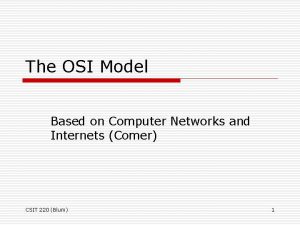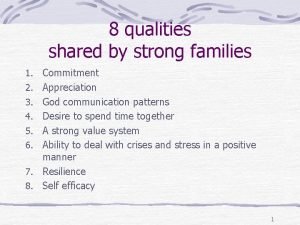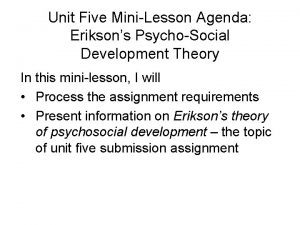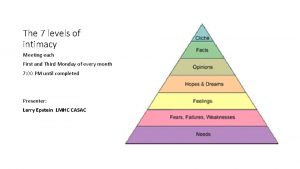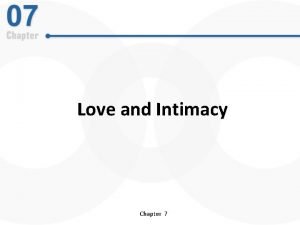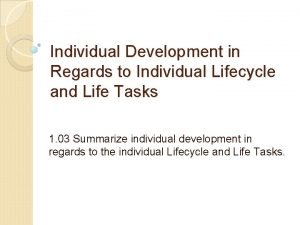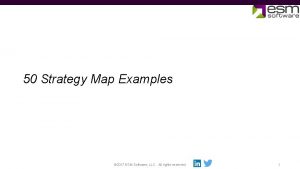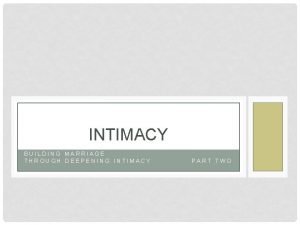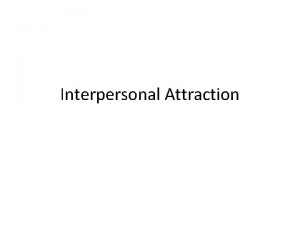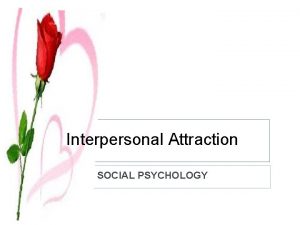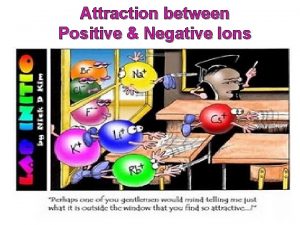Intimacy and Attraction Take Away Points What are






































- Slides: 38

Intimacy and Attraction

Take Away Points • What are the 4 conditions for intimacy? • Interpersonal Magnets • Know the 6 listed on this Power. Point, their definitions, and examples • Matching hypothesis – (link to symmetry in faces) • Duck’s Filtering Theory of Attraction • Different levels • Be able to classify an example into the proper level • Communicating Attraction Online • What are the 5 best ways?

Overview • What is intimacy? • Who are we intimate with? Attraction • How do we explain who we are attracted to? • Interpersonal Magnets • The Filtering Theory of Attraction • How do we best portray ourselves when communicating attraction?

Intimate Relationships • What is the difference between a romantic intimate relationship and an intimate friendship? • Define • What are the expectations of each?

Conditions for Intimacy • 1. Physical proximity • 2. Shared episodes • 3. Intimacy readiness • Senior year, Valentine’s Day, Romantic dinners • 4. Romantic feelings • Physiological arousal and a cognitive label

Attraction • How do we determine attraction? • How do we communicate attraction?

There are 6 interpersonal “magnets” that attract us to others. Similarities or Differences?

1. Physical attractiveness is the first interpersonal magnet. • Matching hypothesis

Humans view symmetrical faces as more attractive.

Physical Beauty (Little et al. , 2001) • Male facial attractiveness • Symmetry • Development good genes • BUT matching hypothesis • Females with lower “physical attractiveness” more likely to show preference for male with lower “attractiveness”

Physical Beauty (Little et al. , 2001) • Female participants • Rated their own attractiveness • Could change the faces to make them “more attractive”

People prefer partners of similar physical attractiveness.

Discussion Question • How does communication differ (if at all) if you’re talking to someone below, at, or above your “matching” attractiveness level?

Attractiveness is culturally defined.

2. Similarity is the second interpersonal magnet.

In what areas do we want similarity in a romantic partner? • Interpersonal skill levels • Cognitive complexity • Values • Any others? ? ?

3. Reciprocal liking is the third interpersonal magnet.

4. The need for affection is another aspect that should be similar.

5. Relational partners often have complementary needs, such as the need for inclusion.

6. Another complementary need is the need for control. Autocrat (controller) Abdicat (gives control)

Duck’s Filtering Theory of Attraction

Duck’s Filtering Theory Sociological Pre-interaction Interaction Cognitive Cues Attraction

Level one involves sociological or incidental cues.

Level 2 pertains to other pre-interaction cues, such as physical appearance and artifacts.

Level 3 uses interaction cues. • Conversational skills • Reciprocal liking • More interactions decrease filters 1 & 2

Level 4 focuses on cognitive cues about attitudes, beliefs, values, personality, etc. Sociological Pre-interaction Interaction Cognitive Cues Attraction

Think of a person you have been interested in romantically. Write down brief description of each filter level. If it didn’t work out, at which level did it fail?

Communicating attraction can be studied in online dating sites.

Online Dating • Communication scholars say that a relationship is more than the sum of two individuals. How would that play a role in online dating? • http: //papers. ssrn. com/sol 3/papers. cfm? abstract_id=945389

How do people communicate attraction online? • Publish “advice pieces” • First message • Profile picture • Attractiveness ratings

Be literate when communicating in a first message. • The average reply rate is 32%

Avoid physical compliments in a first message.

Bring up specific interests in a first message.

Be specific to the person in the first message.

Use an unusual greeting in a first message.

How do the Ok. Cupid rules apply to small talk or talking to a person for the first time? • Do these rules apply to texting?

Take Away Points • What are the 4 conditions for intimacy? • Interpersonal Magnets • Know the 6 listed on this Power. Point, their definitions, and examples • Matching hypothesis – (link to symmetry in faces) • Duck’s Filtering Theory of Attraction • Different levels • Be able to classify an example into the proper level • Communicating Attraction Online • What are the 5 best ways?

References • Little, A. C. , Burt, D. M. , Penton-Voak, I. S. , & Perrett, D. I. (2001). Self-perceived attractiveness influences human female preferences for sexual dimorphism and symmetry in male faces. Proceeding of the Royal Society, 268, 39 -44.
 Antigentest åre
Antigentest åre Take away points
Take away points Matching hypothesis
Matching hypothesis Take-away points
Take-away points Go away spooky ghost
Go away spooky ghost Ent mekatronik
Ent mekatronik Root locus
Root locus Take away sins
Take away sins Principle hair design
Principle hair design Use excessive force if things don't quite slip into place
Use excessive force if things don't quite slip into place Lamb of god takes away the sins of the world
Lamb of god takes away the sins of the world Please do not throw sausage pizza away
Please do not throw sausage pizza away John 11:39
John 11:39 Bull's eye brand positioning
Bull's eye brand positioning Point of difference and point of parity
Point of difference and point of parity Take a bus or take a train
Take a bus or take a train Customer relationship management and customer intimacy
Customer relationship management and customer intimacy Intimacy and passion without commitment
Intimacy and passion without commitment Achieving operational excellence and customer intimacy
Achieving operational excellence and customer intimacy Customer intimacy operational excellence
Customer intimacy operational excellence Customer relationship management and customer intimacy
Customer relationship management and customer intimacy Customer relationship management and customer intimacy
Customer relationship management and customer intimacy Maladaptation of intimacy vs isolation
Maladaptation of intimacy vs isolation 7 levels of intimacy
7 levels of intimacy What is emotional intimacy
What is emotional intimacy How to resolve a love triangle
How to resolve a love triangle Friendly relationship manhwa 7
Friendly relationship manhwa 7 Anal personality
Anal personality Intimacy vs isolation
Intimacy vs isolation Trust vs mistrust
Trust vs mistrust Contoh implementasi get keep and grow di suatu perusahaan
Contoh implementasi get keep and grow di suatu perusahaan Dua for intimacy
Dua for intimacy Autonomy vs shame and doubt
Autonomy vs shame and doubt Waardestrategie porter
Waardestrategie porter Intimacy after incarceration
Intimacy after incarceration Sample strategy map
Sample strategy map Becoming one intimacy in marriage
Becoming one intimacy in marriage Intimacy motivation
Intimacy motivation Strategy maps examples
Strategy maps examples











